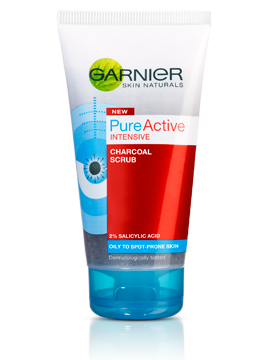 Featured Guest Blog Post Beauty by the Geeks is a blog that wants to de-mystify all the science behind beauty products and all your beauty bothers. Tonnes of products are being sold with science but what does it all really mean?! We're going to try our best to explain the science behind beauty so LET THE BEAUTY MEET THE GEEK!! How does a good face scrub actually work? What are the active ingredients and what do they do? Beauty By The Geeks take us to the lab bench and teach us what every scientista should know about face scrub chemistry! Garnier’s new scrub, Pure Active Intensive Charcoal, grabs our attention with its unusual ingredients and dark colour, making claims to absorb dirt and oil and to dissolve impurities and fade the look of blemishes. Sounds promising, so what makes this scrub the new wonder product? The two main active ingredients in this scrub are salicylic acid, and of course, the title-featured charcoal. Let’s take a look at the science behind these ingredients and what they can actually do to help our skin! Salicylic Acid This is a common ingredient in many skincare products and appears in concentrations of 2% in Garnier’s new charcoal scrub. Salicylic acid has desmolytic properties, meaning that it aids the breaking down and shedding of the connective tissues in our skin. By helping our skin to shed, this reduces the chances of blocked pores and infections and other things that aren’t ideal when we’re trying to look our best, leaving behind newer, clearer skin. For similar reasons, salicylic acid helps to eliminate blemishes, and even helps to reduce long-term scarring. Therefore, it not only prevents skin problems but actually combats previous damage! Charcoal Over the last few years, we have seen an increase in the skin care products featuring charcoal, or more specifically, activated charcoal, as it appears to effectively absorb oil or sebum on our skin. Activated charcoal is carbon specifically processed to contain more pores, and it is these pores which can “absorb” different molecules. Sebum is the oil on our face and hair that, in normal quantities, acts as a protective agent. But in too high amounts, it can lead to a “greasy appearance” and block pores. Activated charcoal manages to reduce amounts of this oil, by way of its structure, leaving behind cleaner, fresher skin. The gender-neutral packaging of this product, with its blues and oranges, seems like it is designed for both men and women, but don’t let this put you off ladies! If you have a more oily skin type or skin that frustratingly still won’t accept that you are no longer a teenager, then this product is for you. The active ingredients help to improve the appearance of trouble-prone skin and are fantastic for everyday use to prevent the build-up of blocked pores and blemishes. Plus, of course, there’s the dark grey colour of this product, which allows us to pretend we are having a luxurious spa treatment—so what’s not to love? References: http://www.ncbi.nlm.nih.gov/pmc/articles/PMC3366450/ http://www.activated-carbon.com/ http://www.ncbi.nlm.nih.gov/pubmed/23688232 http://www.garnier-pureactive.co.uk/#!/products/garnier-pure-active-intensive-charcoal-scrub About the Bloggers The Geeks behind it Let us introduce ourselves! We're Rose Brown and Brigitte West the geeks behind the blog! Hailing from opposite ends of the country, we met at Newcastle University whilst studying medical science degrees. We're not ashamed to admit, WE LOVE SCIENCE! However it's not bacteria on petri dishes that gets us ticking, it's the science behind our beauty products! We started the blog for that exact reason to show the female population that science isn't what it used to be. We want to acknowledge and highlight the pioneering work of female scientists and use beauty as the vehicle to encourage young girls into science! Let's bulldoze the anorak stereotype and introduce the sassy side of science! Comments? Leave them below!
2 Comments
Will
7/21/2014 06:10:44 am
Is it possible to have sudsing, sulfate free shampoo. If yes then what are the alternatives to Sulfates naturally derived if possible
Reply
Your comment will be posted after it is approved.
Leave a Reply. |
LIFESTYLE BLOGRead our lifestyle advice, written exclusively for pre-professional women in science and engineering. From advice about fashion, work and family balance, self, wellness, and money, we've got you covered! |
The Scientista Foundation, Inc. All Rights Reserved © 2011-2021 | Based in NY | [email protected]
The Network for Pre-Professional Women in Science and Engineering
The Scientista Foundation is a registered 501(c)(3) -- Donate!
The Network for Pre-Professional Women in Science and Engineering
The Scientista Foundation is a registered 501(c)(3) -- Donate!

